By: Grillo_Parlante
In my last article I discussed blurring archetypes, using as a centerpiece example pauper goblins for an aggro-control deck, and providing a number of low-power examples of this principle being applied. Not unreasonably, a number of readers pointed out that it would have been nice to have some higher power examples, and I’m here today to do just that. We are going to go through a mock design process, taking insights from pauper goblins to hopefully design an aggro-control archetype for a higher powered format.
First, let’s look at a slightly more recent goblins list:
cspickle (4 - 0), Pauper Daily #8373448 on 2015-06-11
A more aggressive variant than our original example, it still has all of the essential pieces: ample sources of pressure, resilient threats, and board control tools. The deck can quickly curve out and kill like a Sligh deck, or it can take a more controlling axis. For the curious, its control plan is described here. We concluded that the elements for an aggro-control archetype in cube involved providing the following for an aggro player:
1. Sources of incremental value
2. Removal or other disruption that supports an aggro strategy
3. Variety
But just as any of the other major archetype labels can encompass a broad variety of sub-strategies (e.g. draw-go control vs. tap-out control), there are a number of different ways to support aggro-control. Since we’re using goblins as our guide, we have to first ask ourselves what type of aggro-control deck we are dealing with.
And the answer is that it’s an aristocrats deck.
This particular deck type has some existing relevance to the cube community thanks to Gravecrawler, but recent printings from Khans block have essentially revamped the archetype, letting us innovate on what will hopefully be somewhat familiar ground.
But what is an aristocrats deck? Put simply, it’s an aggressive synergy based deck revolving around sacrifice effects and death triggers. Originally designed by Sam Black (you can read his account of the development here), its constructed laurels rest on it winning Pro Tour Gatecrash. The deck was more or less ported over to cube by Jason Waddell, as described here; and since the deck actively benefits from creature death and runs recursive threats, it naturally did very well in cube formats packed with efficient and powerful removal.
Oftentimes when people talk about this deck, they get caught up in the original vision of a B/W/R sacrifice deck. We are going to stay in that familiar spectrum for the time being (peeking a bit into green), but it’s important to step back and remember that we are applying conceptual pieces. You don’t have to stay in the constraints of those colors. The elements we will be dealing with are described by Sam Black as:
1. The Aristocrats: Carrion Feeder and Goblin Sledder
2. The Travelers: Doomed Traveler and Goblin Arsonist
3. The Fodder: Gravecrawler and Mogg War Marshal
In the above, I provide one example each of cards that could show up in the original Gatecrash deck or a pauper goblins list, respectively. The idea is to combine aggressive fodder with sacrifice outlets, which let you convert those previous investments into some sort of advantage. Travelers are creatures that provide some active benefit when they die.
The key principle is to craft an aggro deck capable of converting its prior investments into value. If a durdly good stuff midrange deck can make up for lost tempo via ETB spell effects attached to fatties, our fast aggro deck can make up for lost tempo by maximizing the number of “leaves the battlefield” spell effects we attach to our creatures. This is the core principle at work (and incidentally why I think Thragtusk represents more value than is healthy for a lot of cube environments).
The original Gravecrawler-based aristocrats deck combined Gravecrawler as a fodder card to be used in conjunction with aristocrats, such as Carrion Feeder, in a zombie tribal package. Recent printings from Khans block, however, have provided an interesting alternative in the form of Bloodsoaked Champion.
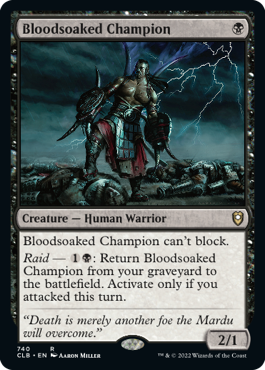
Let’s nail down the essential pieces and then flesh things out with what we’ve learned from Goblins.
The Fodder
Here we are making a shift towards Bloodsoaked Champion. Gravecrawler is certainly still playable, but the need to support zombie tribal, and the awkward mana cost of some of the supporting cards (Bloodghast and Geralf’s Messenger) is a constraint that is no longer necessary. While Bloodsoaked Champion doesn’t necessitate any tribal commitment, it’s worth noting the two creature types: human warrior.
This means we can combine the card with another well-established beater.
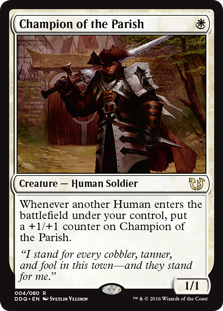
Most cubes already feature a huge density of humans across all colors, and the combination of Champion of the Parish, Bloodsoaked Champion and sac outlets is an outright engine for an aggro deck. The ability to vertically grow a threat adds longevity to the deck’s strategy, as a large Champion of the Parish can compete reasonably well on a board against other large midrange creatures. Meanwhile, the Bloodsoaked Champion provides an element of inevitability against aggro’s other main concern—removal heavy decks.
It gets better, though.
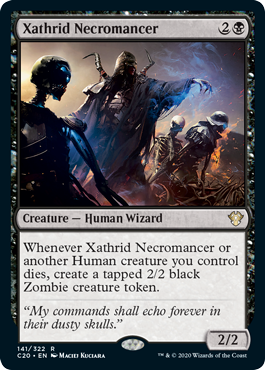


Necromancer in conjunction with a recurring Bloodsoaked Champion is a powerful engine in itself. Goblin Rabblemaster is an excellent aggro beater that can trigger raid, and provide an endless source of tokens to sacrifice.
Mardu Strike Leader’s dash ability (and to a lesser extent Lightning Berserker and Mardu Shadowspear) provides pressure from multiple angles: pumping Champion of the Parish, triggering raid, and providing a token to sacrifice. In addition, dash plays around sorcery speed removal, demanding that an opponent have a diversified removal suite.
It’s worth mentioning there are many other cards that can act as fodder. Any sort of cheap vanilla persist or undying creature would qualify, as would cards like Mogg War Marshal, Chandra’s Phoenix, or Loyal Cathar.
The Aristocrats
Ideally, we want cheap 1-2 mana creatures with no mana or tapping cost. The best options are:


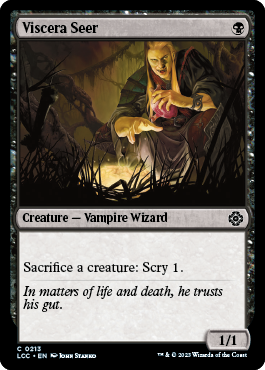
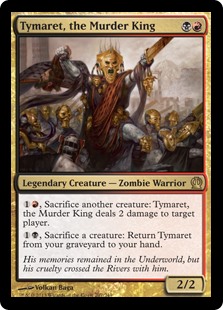
Slim pickings. Tymaret is so on par with the overall strategy that it would be a mistake not to consider him, especially since his creature types—warrior zombie—may be relevant to our setup. Cartel Aristocrat is quite good and provides a lot of interactivity on a cluttered board. Carrion Feeder and Viscera Seer are good, cheap sacrifice outlets.
There are a few 2cc non-creature cards to consider: Goblin Bombardment and Blasting Station. Greater Gargadon is also an excellent sacrifice outlet in formats that are not too fast for him.
Once we move up the mana curve, however, things become more powerful.
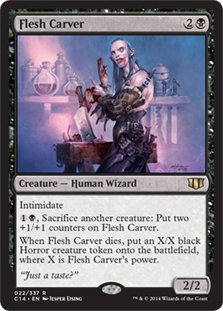
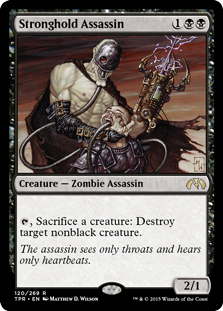
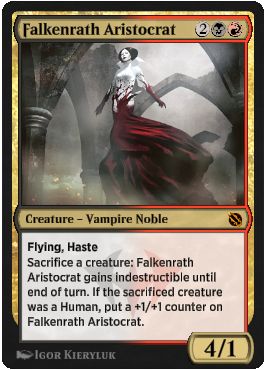
Flesh Carver and Stronghold Assassin require either tapping or mana to sacrifice a creature, but make up for this in terms of power level. There are a number of non-creature sacrifice outlets that also could be run—such as Attrition or Mind Slash—that I don’t recommend as I find they lead to frustrating gameplay.
The Travelers
These are, of course, named after Doomed Traveler. In cube, the best examples would be Tuktuk the Explorer and Perilous Myr. While there are only a limited number of cubeable cards that squarely fit this category, there are lots of creatures that provide creative ways to garner value upon their death. Sacrificing a Mesmeric Fiend (or Tidehollow Sculler), with its trigger on the stack, is a good example. In general, creatures with keywords that doom them to death are our likely travelers. This includes creatures with vanishing, haunt, persist, undying, fading, unearth, evoke, or echo.
There is also a subset of cards that provide value from other creatures dying. Cards like Skirsdag High Priest, Blood Artist, and Sylvok Lifestaff. This card pool also encompasses creatures that grow based on graveyard count (Bonehoard), cards that grow vertically upon creature death (Rockslide Elemental), or just useful triggers like Athreos, God of Passage, Hissing Iguanar, Xathrid Necromancer, and Grim Haruspex. Delve or threshold cards also fit loosely into this category.
The Red Crush
So now that we’ve gone over the basic framework of the archetype, let’s flesh things out a bit, taking inspiration from our pauper goblins. At the moment, we are supporting a low to the ground, removal resistant aggro archetype with sources of card advantage that can grind out a win in the mid to late game if need be. We also have some elements of vertical growth via Champion of the Parish and horizontal growth, thanks to Xathrid Necromancer, Goblin Rabblemaster, and Mardu Strike Leader.
We want all of the same tools that pauper goblins has, just dialed up to our power level: 1) ways to leverage sacrifices into board control, 2) tutors, and 3) burst damage. We need to emulate the effects of cards like Sparksmith, Sylvok Lifestaff, Goblin Bushwhacker, Goblin Matron, and Death Spark, which thankfully we can do.
Board Control
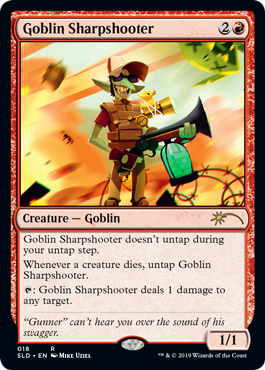
An unanswered Goblin Sharpshooter can dominate a board when combined with sacrifice support. Goblin Bombardment can have a similar effect, and the two of them combined can really pose a problem for an opponent on a creature based plan, taking over a board with the assistance of recursive threats and expendable creatures.
These sorts of strategies coincidentally get better with a large store of fodder, and Khans block has given us a card that can fill a variety of roles: threat, removal, or sacrifice fuel.
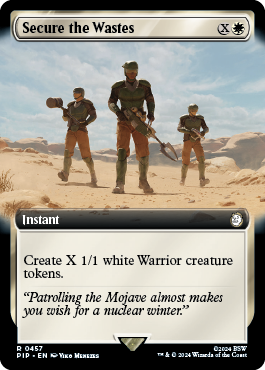
What a great card for an aggressive aristocrats deck. Outside of being a mana sink, it can act as a surprise threat or help control the board with its tokens. It eloquently supports both the control and aggro axes of the deck.
Raise the Alarm and Midnight Haunting also fill similar roles. Lingering Souls may be a sorcery speed card, but flashback provides another source of board control and pressure.
Burst Damage and Tutors
So now we have a token element that supports both the aggro and the control elements of our strategy. However, we need a Goblin Bushwhacker clone to provide an additional strategic axis based around perceived pressure, rather than actual pressure.
And this brings us to a discussion of anthem effects, most of which are either way too expensive or don’t come attached to a body (problematic for a deck built around sacrificing bodies). Worst of all, many of them are extremely narrow, having no other application than closing out the game. One of the most interesting things about Goblin Bushwhacker is its ability to provide haste, and it would be nice to have an anthem effect active at more stages of the game. Thankfully, the perfect card exists.

An anthem effect that adds a relevant body and which can lead to all sorts of interesting interactions at all phases of the game. This is exactly what we want.
Finally, it would be nice to have a tutor effect like Goblin Matron; and we can easily have this in the form of Imperial Recruiter. In addition, we have an interesting option in green in the form of Collected Company.
So far so good, but how close are we to fulfilling our aggro-control elements? Do we have an aggressive deck that supports:
1. Sources of incremental value
2. Removal or other disruption that supports an aggro strategy
3. Variety
Our entire deck is built around the concept of incremental value and we have access to removal pieces that fit our strategy. We have vertical growth, horizontal growth, sources of burst damage, hand disruption, and removal -resistant threats. We can come out racing, putting an opponent under intense pressure, or we can play a longer grindy game with our sacrifice value engines. Instead of a fragile Sligh deck attacking along a single axis, we now have a dynamic aggro deck; one which we can even expand on if we wish:
Aggro-Combo
We can add aggro-combo elements via a few white double-strike creatures, and copies of Feat of Resistance, Ajani, Caller of the Pride, Vines of Vastwood, or Become Immense. Silverblade Paladin and Mirran Crusader make their way comfortably into higher power environments; while somewhat more niche are Fabled Hero and Arashin Foremost. The latter is probably currently too narrow, but has some interesting interactions with black’s dash warriors, Secure the Wastes, and Mardu Woe-Reaper.
Value Reanimation
Cards like Unearth, Victimize, Stitch Together and Alesha, Who Smiles at Death can add an interesting value reanimation axis that lets you reuse travelers to maximize incremental gain.
Persist Combo
Another Khans block gift is Anafenza, Kin-Tree Spirit, which means we don’t have to choose between running cards like Melira, Sylvok Outcast, or upping the mana curve to support persist combo.
Conclusion
There are, of course, other ways to design aggro-control decks. You can focus more on the disruptive aspects if you wish, concentrate on tempo advantage, or experiment with applying this style of deck to other color combinations (or even ultimately bump it up to a midrange deck). This isn’t intended as a piece to be strictly followed, but rather to help people unhappy with their aggro sections think critically about what they can change. Hopefully, walking through a mock design process will have made that a little easier to do.
Happy drafting.
***Also, credit to Safra on the forums for posting similar decks, and getting me thinking about the archetype.




